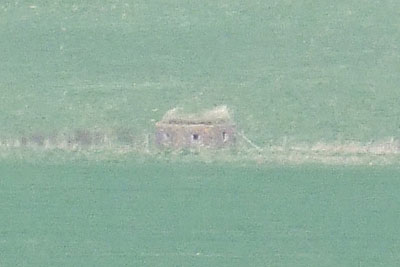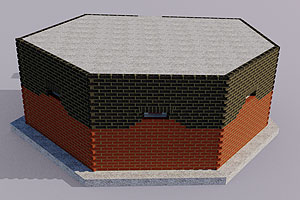Artillery observation post
Posted: 15 March 2009 20:26
I went up onto the downs today, but this wasn't a Downsforce expedition; I was looking for an artillery observation post (OP) on Windover Hill and I think I've found it.
I had a busy day; the weather was hot and sunny and I wanted to do a couple of other things in the Cuckmere Haven area too.
I had the OP grid reference from a 1941 document and had also converted it to National Grid to give me a better chance of finding it. My experience is that however inaccurate a grid conversion may be (mine might often be 100m out), searching for a small feature in the landscape can be a needle/haystack exercise and any clue can make a difference.
Using GPS to take me to the rough area, I began putting too much reliance on grid references and map reading of both modern and wartime sheets. I then remembered reading a Canadian document about platoon tactics that warned commanders of the dangers of planning from the map and not the ground. I was going about this the wrong way and ignoring one of my golden rules which is to let the landscape do the talking.
I turned the problem around and looked at it from a different angle; I knew the location of the gun battery (four 25-pounders at Polegate) and had a list of its main tasks. Although the OP didn't need to be able to see the battery itself, it obviously follows that it would be at a spot where the targets could be observed - that's what it was there for.
I then abandoned maps, grid references and GPS and started walking the ground in an area where all the targets were visible.
I finally struck gold with this trench.

It was slightly larger than a standard slit trench, which is of no surprise, as I expect an OP would house at least two observers along with map board, optical equipment, field telephone and other paraphenalia.

Looking at the profile, it seemed clear that the spoil from the trench had been thrown up along the long sides to create a parapet.
Settling down into the trench, I got out my 1941 binoculars to get an authentic view of the landscape.
One of the targets was Wilmington Aerodrome, upon which this thin-walled Type 24 pillbox still stands; I mentioned this in one of my earliest posts on anti-invasion defences back in April 2006.
I could have spent a lot of time with binos and map just observing targets, but I had to press on another batch of targets myself; I was heading off to Cuckmere Haven next.
- Pete

Email:
Blog Latest

Bishopstone reveals its pillbox secrets
18 October 2021

Pillbox or Observation Post?
10 June 2020

Uncovering the hidden secrets of a pillbox
8 June 2019

Review of 2018
31 December 2018

Wartime Christmas in East Sussex (2)
24 December 2018
Jargon-buster
Pillbox
Generic term for a hardened field defensive structure usually constructed from concrete and/or masonry. Pillboxes were built in numerous types and variants depending on location and role.
Slit trench
Small, narrow trench designed to provide protection against shrapnel and other battlefield hazards. Technically distinct from a weapon pit (which was intended soley as a defensive position) slit trenches were also used as defence works.

Type 24 pillbox
A six-sided (but not a regular hexagon) pillbox. The Type 24 is the most frequently seen pillbox in East Sussex, mostly along stop lines. It can be found in thin wall (30cm) or thick wall (1m) variants.
This site is copyright © Peter Hibbs 2006 - 2024. All rights reserved.
Hibbs, Peter Artillery observation post (2024) Available at: http://pillbox.org.uk/blog/216614/ Accessed: 27 July 2024
The information on this website is intended solely to describe the ongoing research activity of The Defence of East Sussex Project; it is not comprehensive or properly presented. It is therefore NOT suitable as a basis for producing derivative works or surveys!